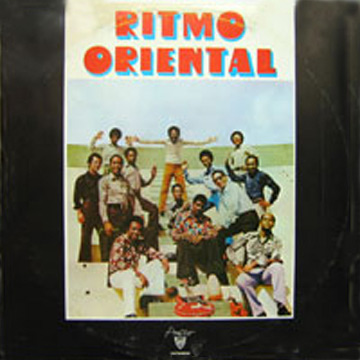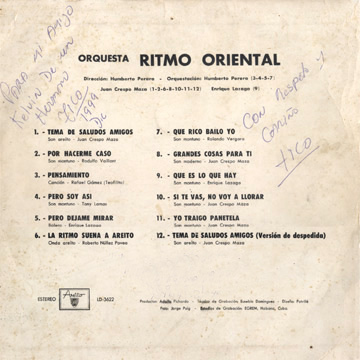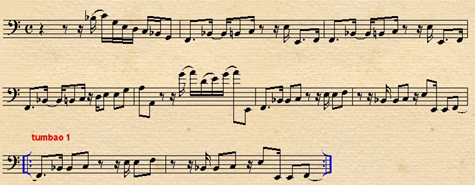Indice - Table of contents
New Stuff[hide]
Reportes: From The St... : Cubadisco 2...
Fotos: Tom Ehrlich
Staff: Kristina Lim
Musicos: Juan Formell
Musicos: Yordamis Megret Planes
Musicos: Yasser Morejón Pino
Musicos: José Luis "Changuito" Quintana...
Musicos: Dennis Nicles Cobas
Fotos: Eli Silva
Grupos: Ritmo Oriental : 1988 - Vol. IX - 30 a...
Musicos: Rafael Paseiro Monzón
Musicos: Jiovanni Cofiño Sánchez
Fotos: Tom Ehrlich : 2024 Monterey Jazz, P...
Resenas: Vacilón Santiaguero (Circle 9 ...
Photos of the Day [hide]
The Roots of Timba - Part II - January, 1977 - Tema de saludos amigos

1977 - LD-3622 - The CA-1389-1390 Sessions

| CA1389 | Tema de saludos amigos | Juan Crespo Maza | s | LD3622 |
| CA1389 | Por hacerme caso | Rodulfo Vaillant | s-mt | LD3622 |
| CA1389 | Pensamiento | Rafael Gómez | canción | LD3622 |
| CA1389 | Pero soy así | Tony Lama | s-mt | LD3622 |
| CA1389 | Pero déjame mirar | Enrique Lazaga | b | LD3622 |
| CA1389 | La Ritmo suena Areíto | Roberto Núñez | on-areíto | LD3622 |
| CA1390 | Qué rico bailo yo | Rolando Vergara | s-mt | LD3622 |
| CA1390 | Grandes cosas para tí | Juan Crespo Maza | s-mt | LD3622 |
| CA1390 | Qué es lo que hay | Enrique Lazaga | s-mt | LD3622 |
| CA1390 | Si te vas no voy a llorar | Juan Crespo Maza | s-mt | LD3622 |
| CA1390 | Yo traigo panetela | Juan Crespo Maza | s-mt | LD3622 |
| CA1390 | Temo de saludos amigos (reprís) | Juan Crespo Maza | s-areíto | LD3622 |
1977 Ritmo Oriental- Tema de saludos amigos (J.C. Maza)
bass: Humberto Perera - arranger: JC Maza
source: write EGREM
Perhaps inspired by Van Van, La Ritmo's third album of the 70s is given a degree of thematic unity by reprising the opening track at the end, and by re-using the lyrical theme of onda areíto in the closing track of side A, La Ritmo suena Areíto, the album's musical climax.
Throughout the album, Humberto Perera's bass playing rises to an even higher level than his previous work -- in terms of creativity, virtuosity, and compositional interplay with the string guajeos.
The basic pattern of bass tumbao 1 is just doubled bombo-doubled ponche, but Humberto makes it melodically distinct and marks every other 3-side with a singing figure that jumps into the upper register to fill a hole left by the strings:
xx0x 0xxx 0xx0 xxx0 2-3 rumba clave
000x xx00 xxx0 000x string guajeo
xxxx xxxx xxx0 0x00 (bass pickups)
xxx0 0x00 xxx0 0x00
xxx0 0x00 x0x0 0x00 tumbao 1 -- MIDI
Bass tumbao 2 accompanies the song's catchiest coro (vengan a bailar con Areíto). The tumbao is basically bombo-ponche but Humberto never plays it exactly the same way twice.
Bass tumbao 3 switches from bombo-ponche to guajeo style. Humberto plays many variations, but the signature upward hammer-on melody remains intact and he always hits the downbeat of the 2-side:
xx0x 0xxx 0xx0 xxx0 2-3 rumba clave
0xxx xx00 xxx0 0x00 bass variation 1 - MIDI
0xxx xx0x xxx0 0x00 bass variation 2 - MIDI
1977 Ritmo Oriental- Por hacerme caso (Rodulfo Vaillant)
bass: Humberto Perera - arranger: JC Maza
source: write EGREM
xx0x 0xxx 0xx0 xxx0 2-3 rumba clave
00xx x000 xxx0 00xx
00xx x000 xxxx 00xx tumbao 1 -- MIDI
Por hacerme caso, an amazing track in many ways, is the first of several tracks written for La Ritmo by Rodulfo Vaillant, the Santiago-based composer/producer said to have made the first demo recordings of Irakere.
The string guajeo of the first tumbao is very similar to that of the first tumbao of Tema de saludos amigos but Humberto uses completely different approaches to the bass tumbao. In Tema de saludos he answers the string figure but here in Por hacerme caso he doubles it, motivo style.
With the strings and bass playing the same rhythm, it leaves space for the undermixed piano to shine through more than usual and you can hear that he's playing the standard, traditional piano tumbao (0x00 x0x0 x0x0 x0x0).
Many American salsa musicians affectionately refer to this piano figure to as "Rebeca 1A" because so many of them first encountered it in Rebeca's Mauleón's famous Salsa Guidebook for Piano & Ensemble, probably the most influential Latin music method book ever written. If you're one of the readers waiting for our timba piano chapters, a good way to prepare yourself for the breakthroughs of timba is to study this, and its sequel, 101 Montunos. These books will give you a solid understanding of pre-timba piano styles and get you ready to withstand the shock of Melón, Tirso, Rolando, Noroña et al.
The second coro section is an exquisite example of rhythmic counterpoint, bringing to mind another musical conversation 21 years later.
Let's eavesdrop on the individual elements of the conversation, beginning with the bass tumbao and the clave, which overlap only once per cycle:
xx0x 0xxx 0xx0 xxx0 2-3 rumba clave
000x xx0x x00x 000x
000x xx0x x00x 000x bass -- MIDI
Now let's add the piano. In most RO breakdowns, the bass continues while the strings and piano drop out, but here, the piano sticks around and departs from its standard rhythm to engage in an inspired conversation with the coro:
0x00 x0x0 x0x0 x0x0 standard piano tumbao
xxxx 00x0 x0x0 xxxx
xxxx 00x0 x0x0 x00x Por hacerme caso piano tumbao 2
The piano and bass tumbaos lock together beautifully:
xxxx 00x0 x0x0 xxxx piano
000x xx0x x00x 000x bass
xxxx 00x0 x0x0 x00x piano
000x xx0x x00x 000x bass - MIDI
All of this syncopation is balanced by an extremely unsyncopated comparsa-esque coro:
0x0x 0x0x 0x0x 0x0x yo traigo este ritmo que'está
0x0x 0xx0 xxxx xxxx muy sabroso
0xxx 0xx0 xxxx xx0x baila e me
0x0x 0xx0 xxxx xxxx tiene loco
Listen to the interplay between the coro and the angular bass tumbao:
coro 2 audio - MIDI
0x0x 0x0x 0x0x 0x0x yo traigo este ritmo que'está
000x xx0x x00x 000x bass
0x0x 0xx0 xxxx xxxx muy sabroso
000x xx0x x00x 000x bass
0xxx 0xx0 xxxx xx0x baila e me
000x xx0x x00x 000x bass
0x0x 0xx0 xxxx xxxx tiene loco
000x xx0x x00x 000x bass
Finally let's put it all together and listen in super slow motion:
coro 2 audio - super slow MIDI
xx0x 0xxx 0xx0 xxx0 2-3 rumba clave
xxxx 00x0 x0x0 xxxx
xxxx 00x0 x0x0 x00x piano tumbao
000x xx0x x00x 000x
000x xx0x x00x 000x bass tumbao
0x0x 0x0x 0x0x 0x0x
0x0x 0xx0 xxxx xxxx
0xxx 0xxx 0xxx xx0x
0x0x 0xx0 xxxx xxxx coro
For tumbao 3, Humberto takes two common songo bass rhythms and combines them into a 2-clave pattern while his choice of notes adds R&B flavor.
xx0x 0xxx 0xx0 xxx0 2-3 rumba clave
0x0x xx0x x0xx 0x0x
0xx0 0xx0 x0xx 0x0x tumbao 3 -- MIDI
We can't leave Por hacerme caso without mentioning the wild con efecto bloque at the end of the introduction. Aside from the tempo changes, it's one of the most ambiguous passages of the entire era. Shown in raw form, it looks like this:
0000x00000x000000000000x flute
0xxxxx0xxxxx0xxxxxxx0x0x bass
It could be perceived as 4 measures of 3/4:
0000x0 0000x0 000000 00000x flute
0xxxxx 0xxxxx 0xxxxx xx0x0x bass
... or 2 measures of 12/8:
000 0x0 000 0x0 000 000 000 00x flute
0xx xxx 0xx xxx 0xx xxx xx0 x0x bass
... or one and a half measures of 4/4:
0000 x000 00x0 0000 0000 000x flute
0xxx xx0x xxxx 0xxx xxxx 0x0x bass
Ritmo guru Rob Holland hears it at 4 measures of 3/4, so we'll go with that! (The last measure is Daniel Díaz bringing the band back in.)

Por hacerme caso introduction bloque - transcription by Rob Holland
1977 Ritmo Oriental - Pero soy así (Tony Lamas)
bass: Humberto Perera - arranger: Humberto Perera
source: write EGREM
xx0x 0xxx 0xx0 xxx0 2-3 rumba clave
xxx0 0x0x xxx0 0x0x
xxx0 0x0x x0x0 0x0x tumbao 1 -- MIDI
By the late 70s, bombo-ponche bass tumbaos like tumbao 1 were becoming more and more common. Humberto makes this one interesting by switching octaves and, as he often did, by marking the clave every other time with an extra melodic note on the quinto pulse.
The bass playing is so beautiful on the transition from the cuerpo to tumbao 1 that it cries out to be transcribed note for note:
 Pero soy así - transition from cuerpo to tumbao 1 audio -- MIDI
Pero soy así - transition from cuerpo to tumbao 1 audio -- MIDI
Humberto plays endless variations of tumbao 1 as the arrangement progresses through several coros and a nice set of (non-con efecto) bloques.
The last tumbao could be thought of as yet another variation of the first, but Humberto inserts what in classical music is called a "deceptive cadence". Instead of playing C (in the key of C), he plays A, the relative minor (the underlined note is the deceptive cadence).
normal cadence (I - IV - V - I) (C - F - G - C)
deceptive cadence (I - IV - V - vi) (C - F - G - Ami)
Since all of the notes in the I chord fit with the vi chord, the bassist can force a deceptive cadence by changing one note without any action on the part of the other instruments, (although in this case the strings do change). As such, it's become a part of the bag of tricks of almost every Latin bassist, but this is the earliest example I've stumbled on.
xx0x 0xxx 0xx0 xxx0 2-3 rumba clave
0xx0 x0x0 x00x 00xx
0xx0 x0x0 x00x 00xx string guajeo (underlined notes unique to t2)
xxxx xxxx xxx0 0x0x
xxx0 0x0x x0x0 0x0x
x0xx 0xx0 xxx0 0x0x tumbao 2 -- MIDI -- MIDI w/strings
The catchy string guajeo maintains the same rhythm throughout the track, but changes its notes when the bass switches to tumbao 2 to enhance the deceptive cadence.





















